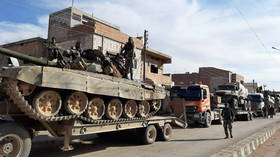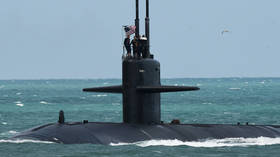
Damascus’ troops and their Iran-backed allies seem to be shifting towards a head-on confrontation with American occupiers

Robert Inlakesh is a political analyst, journalist and documentary filmmaker currently based in London, UK. He has reported from and lived in the Palestinian territories and currently works with Quds News. Director of ‘Steal of the Century: Trump’s Palestine-Israel Catastrophe’.
Robert Inlakesh is a political analyst, journalist and documentary filmmaker currently based in London, UK. He has reported from and lived in the Palestinian territories and currently works with Quds News. Director of ‘Steal of the Century: Trump’s Palestine-Israel Catastrophe’.
@falasteen47

FILE PHOTO: Syrian army units deploying in the village of Abu Rasayn near the town of Ras al-Ain in northeastern Syria. © SANA / AFP
US President Joe Biden rdered airstrikes on a number of positions in northeastern Syria last month, after Washington announced the death of a contractor in a drone strike.
What followed was an unprecedented response from the Syrian Arab Army (SAA) and allied militias, shelling US positions throughout the duration of the following day. This exchange of fire marks a turning point in the conflict between the two sides.
On March 23, the US Department of Defense claimed that a drone, of Iranian origin, had struck US forces stationed near al-Hasakah, in northeastern Syria, killing an American contractor and injuring a number of service members. To which F-15 fighter jets were launched from Doha in order to target Iranian-allied militia groups in the Deir ez-Zor province of Syria. Throughout recent years there have been several exchanges between US and Iranian-allied militia groups in Syria’s east. However, these rarely resulted in American casualties and the brief escalations were controlled.
What changed following the US strikes on March 24 is that there was intense return fire from not only Iranian-aligned militias in Deir ez-Zor, but also from the SAA itself. A number of US bases were struck in the response, which primarily targeted American forces around the al-Omar oil fields, inflicting traumatic brain injuries on six US troops, according to the Pentagon. During a trip to Canada the following day, Joe Biden remarked that the US was “not going to stop” when asked about retaliating against Iran for the exchange in Syria. “Be prepared for us to act forcefully to protect our people” he said.

Read more
It later emerged that the Biden administration had moved one of its aircraft carriers, the USS George H.W. Bush, closer to Syria, which, deputy Pentagon press secretary Sabrina Singh explained, was due to “increased attacks from [Iran’s Islamic Revolutionary Guard Corps (IRGC)]-affiliated groups targeting our service members across Syria.” What this represents, regardless of whatever action the US may take in the future, is a strategic change in the equation set forth by Syria and its allies in Syria’s east. What an Iraqi source with intimate knowledge of the situation claimed had been an “order to now kill American troops and not just fire warning shots.”
According to a Syrian political source, who chose to remain anonymous for security reasons, the escalation in the northeast is directly tied to the ongoing Israeli aggression against the country:
“The recent move by Syria and allies is a direct response to a wave of Israeli escalation against the country that began last year. If you remember in August of 2022, there was a similar stand-off between the Americans and IRGC allies in northeastern Syria. The Israeli escalation is directly enabled by the United States, whose officials talked in the past about the importance of the American military presence in Syria for Israel’s war-between-wars campaign against Iran-aligned forces there.”
The “war between wars” is one of Tel Aviv’s inter-war campaigns, where covert operations are carried out against enemy states during a period of relative calm between both sides. Israel’s recent campaign has primarily consisted of operations against Iranian-linked targets, both inside and outside of Iran; it also has included a large number of unannounced airstrikes inside Syria, where members of the IRGC have been targeted, along with allied militia groups. The Israel Defense Forces have a policy of not commenting on these attacks but Prime Minister Benjamin Netanyahu has in the past admitted that “hundreds” of them had taken place over the years.
If Damascus’ new approach of responding forcefully against the US military in northeastern Syria is adopted going forward, it will give Washington only two options: negotiate with Damascus or leave the country completely. If American soldiers are coming home in body bags over maintaining an occupation inside a country that the US public, along with Congress, were never consulted on, the pressure of remaining could become a burden on the Biden administration. This is especially the case at a time when the Arab World is beginning to normalize formal ties with Damascus, in addition to Washington’s NATO ally Türkiye.

Read more
A Syria-Türkiye rapprochement could be essential to forcing the US out of Syria also, as both countries could end up coordinating during any future Turkish offensive against the Kurdish-led Syrian Democratic Forces (SDF) in the northeast. The SDF operate as a kind of US proxy force, allowing for the Americans to use a small number of their own troops to occupy roughly a third of Syria’s territory; included in which are the most fertile agricultural lands and the majority of Syria’s natural resources. Both previous attacks, launched by Ankara in 2018 and 2019, led to a withdrawal of US forces so as to not accidentally cause friction with their NATO ally. In the event that another military operation from Türkiye is launched, Syria could be poised to retake its oil fields, in theory.
The adoption of a head-on confrontation strategy by Iran-aligned groups and the Syrian government could lead to new horizons and to the possibility of a US withdrawal, that is assuming the Biden administration is not wedded completely to the idea of staying.
The statements, views and opinions expressed in this column are solely those of the author and do not necessarily represent those of RT.




